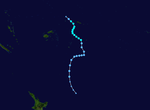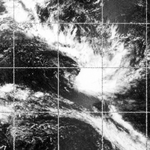1972–73 South Pacific cyclone season
| 1972–73 South Pacific cyclone season | |
|---|---|
 Season summary map | |
| Seasonal boundaries | |
| First system formed | October 19, 1972 |
| Last system dissipated | April 6, 1973 |
| Strongest storm | |
| Name | Bebe |
| • Maximum winds | 155 km/h (100 mph) (10-minute sustained) |
| • Lowest pressure | 945 hPa (mbar) |
| Seasonal statistics | |
| Total disturbances | 8 |
| Tropical cyclones | 8 |
| Severe tropical cyclones | 2 |
| Total fatalities | 24 |
| Total damage | $20 million ( USD) |
| Related articles | |
The 1972–73 South Pacific cyclone season ran year-round from July 1 to June 30. Tropical cyclone activity in the Southern Hemisphere reaches its peak from mid-February to early March.
Seasonal summary
<timeline> ImageSize = width:825 height:230 PlotArea = top:10 bottom:80 right:20 left:20 Legend = columns:3 left:30 top:58 columnwidth:270
AlignBars = early DateFormat = dd/mm/yyyy Period = from:01/10/1972 till:01/05/1973 TimeAxis = orientation:horizontal ScaleMinor = grid:black unit:month increment:1 start:01/10/1972 Colors =
id:canvas value:gray(0.88) id:GP value:red id:TDi value:rgb(0,0.52,0.84) legend:Tropical_Disturbance id:TD value:rgb(0.43,0.76,0.92) legend:Tropical_Depression id:C1 value:rgb(0.3,1,1) legend:Category_1_=_63-87_km/h_(39-54_mph) id:C2 value:rgb(0.75,1,0.75) legend:Category_2_=_88-142_km/h_(55-74_mph) id:C3 value:rgb(1,0.85,0.55) legend:Category_3_=_143-158-km/h_(75-98_mph) id:C4 value:rgb(1,0.45,0.54) legend:Category_4_=_159–204_km/h_(99–127_mph) id:C5 value:rgb(0.55,0.46,0.9) legend:Category_5_=_≥205_km/h_(≥128_mph)
Backgroundcolors = canvas:canvas
BarData =
barset:Hurricane bar:Month
PlotData=
barset:Hurricane width:11 align:left fontsize:S shift:(4,-4) anchor:till from:19/10/1972 till:28/10/1972 color:C3 text:"Bebe" from:02/11/1972 till:03/11/1972 color:C1 text:"Collette" from:08/12/1972 till:18/12/1972 color:C3 text:"Diana" from:14/01/1973 till:18/01/1973 color:C1 text:"Felicity" from:31/01/1973 till:07/02/1973 color:C2 text:"Elenore" from:31/01/1973 till:01/02/1973 color:C1 text:"Glenda" from:28/02/1973 till:02/03/1973 color:C1 text:"Henrietta" from:02/04/1973 till:06/04/1973 color:C2 text:"Juliette"
bar:Month width:5 align:center fontsize:S shift:(0,-20) anchor:middle color:canvas from:01/10/1972 till:01/11/1972 text:October from:01/11/1972 till:01/12/1972 text:November from:01/12/1972 till:01/01/1973 text:December from:01/01/1973 till:01/02/1973 text:January from:01/02/1973 till:01/03/1973 text:February from:01/03/1973 till:01/04/1973 text:March from:01/04/1973 till:01/05/1973 text:April
TextData =
pos:(569,23) text:"(For further details, please see" pos:(713,23) text:" scales)"
</timeline>
Systems
Severe Tropical Cyclone Bebe
| Category 3 severe tropical cyclone (Australian scale) | |
| Category 3 tropical cyclone (SSHWS) | |
| Duration | October 19 – October 28 |
|---|---|
| Peak intensity | 155 km/h (100 mph) (10-min); 945 hPa (mbar) |
Tropical Cyclone Bebe was a pre-season storm that impacted the Gilbert, Ellice, and Fiji island groups.[1] First spotted on October 20, the system intensified and grew in size through October 22. Its course began along a south-southwest trajectory before recurving near the 14th parallel south, which resulted in a south-southeast motion through the western portion of the Fiji island group.[1] It became the first cyclone to impact Fiji since 1952. On October 24, winds of 150 knots (280 km/h) or more were reported on Rotuma and Viti Levu. Cyclone Bebe passed through Funafuti on Saturday 21st and Sunday 22 October 1972. At about 4 p.m. on the 21st, sea water was bubbling through the coral on the airfield with the water reaching a height of about 4 –5 feet high. The Ellice Islands Colony's ship Moanaraoi was in the lagoon and survived, however 3 tuna boats were wrecked. Waves broke over the atoll. Five people died, two adults and a 3 month old child were swept away by waves, and two sailors from the tuna boats were drowned.[2] Cyclone Bebe knocked down 90% of the houses and trees. The storm surge created a wall of coral rubble along the ocean side of Funafuti and Funafala that was about ten to twelve miles long, and about ten to twenty feet thick at the bottom.[2] The cyclone submerged Funafuti and sources of drinking water were contaminated as a result of the system's storm surge and fresh water flooding. After passing by the archipelago, Bebe transitioned into an extratropical cyclone, with the remnants last noted on October 28.[1] A total of 28 people died and thousands were left homeless. Damages totaled $20 million (1972 USD).[3]
Tropical Cyclone Collette
| Category 1 tropical cyclone (Australian scale) | |
| Tropical storm (SSHWS) | |
| Duration | November 2 – November 3 |
|---|---|
| Peak intensity | 75 km/h (45 mph) (10-min); 990 hPa (mbar) |
Collette existed from November 2 to November 3.
Severe Tropical Cyclone Diana
| Category 3 severe tropical cyclone (Australian scale) | |
| Category 2 tropical cyclone (SSHWS) | |
| Duration | December 8 – December 18 |
|---|---|
| Peak intensity | 130 km/h (80 mph) (10-min); 965 hPa (mbar) |
Diana existed from December 6 to December 18.
Tropical Cyclone Felicity
| Category 1 tropical cyclone (Australian scale) | |
| Tropical storm (SSHWS) | |
| Duration | January 14 – January 18 |
|---|---|
| Peak intensity | 75 km/h (45 mph) (10-min); 990 hPa (mbar) |
Felicity existed from January 14 to January 18.
Tropical Cyclone Elenore
| Category 2 tropical cyclone (Australian scale) | |
| Tropical storm (SSHWS) | |
| Duration | January 31 – February 7 |
|---|---|
| Peak intensity | 100 km/h (65 mph) (10-min); 980 hPa (mbar) |
Elenore existed from January 31 to February 7.
Tropical Cyclone Glenda
| Category 1 tropical cyclone (Australian scale) | |
| Tropical storm (SSHWS) | |
| Duration | January 31 – February 1 |
|---|---|
| Peak intensity | 75 km/h (45 mph) (10-min); 990 hPa (mbar) |
Glenda existed from January 31 to February 1.
Tropical Cyclone Henrietta
| Category 1 tropical cyclone (Australian scale) | |
| Tropical storm (SSHWS) | |
| Duration | February 28 – March 2 |
|---|---|
| Peak intensity | 75 km/h (45 mph) (10-min); 990 hPa (mbar) |
Tropical Cyclone Juliette
| Category 2 tropical cyclone (Australian scale) | |
| Tropical storm (SSHWS) | |
| Duration | April 2 – April 6 |
|---|---|
| Peak intensity | 100 km/h (65 mph) (10-min); 980 hPa (mbar) |
Juliette existed from April 2 to April 6.
Seasonal effects
| Name | Dates | Peak intensity | Areas affected | Damage (USD) |
Deaths | Refs | ||
|---|---|---|---|---|---|---|---|---|
| Category | Wind speed | Pressure | ||||||
| Bebe | October 19 – 28 | Category 3 severe tropical cyclone | 155 km/h (100 mph) | 945 hPa (27.91 inHg) | Tuvalu, Fiji | |||
| Collette | November 2 – 3 | Category 1 tropical cyclone | 75 km/h (45 mph) | 990 hPa (29.23 inHg) | ||||
| Diana | December 8 – 18 | Category 3 severe tropical cyclone | 130 km/h (80 mph) | 965 hPa (28.50 inHg) | ||||
| Felicity | January 14 – 18 | Category 1 tropical cyclone | 75 km/h (45 mph) | 990 hPa (29.23 inHg) | ||||
| Elenore | January 31 – February 7 | Category 2 tropical cyclone | 100 km/h (65 mph) | 980 hPa (28.94 inHg) | Fiji, Tonga | |||
| Glenda | January 31 – February 1 | Category 1 tropical cyclone | 75 km/h (45 mph) | 990 hPa (29.23 inHg) | ||||
| Henrietta | February 28 – March 2 | Category 1 tropical cyclone | 75 km/h (45 mph) | 990 hPa (29.23 inHg) | ||||
| Juliette | April 2 – 6 | Category 2 tropical cyclone | 100 km/h (65 mph) | 980 hPa (28.94 inHg) | Fiji, Tonga | |||
| Season aggregates | ||||||||
| 8 systems | October 19 – April 6 | 155 km/h (100 mph) | 945 hPa (27.91 inHg) | |||||
See also
Lua error in mw.title.lua at line 346: bad argument #2 to 'title.new' (unrecognized namespace name 'Portal').
- Atlantic hurricane seasons: 1972, 1973
- Eastern Pacific hurricane seasons: 1972, 1973
- Western Pacific typhoon seasons: 1972, 1973
- North Indian Ocean cyclone seasons: 1972, 1973
References
- ^ 1.0 1.1 1.2 Bureau of Meteorology (1975) Tropical Cyclones in the Northern Australian Regions 1971-1972 Australian Government Publishing Service
- ^ 2.0 2.1 Resture, Jane (5 October 2009). Hurricane Bebe 1972. Tuvalu and the Hurricanes: ‘The Hurricane in Funafuti, Tuvalu’ by Pasefika Falani (Pacific Frank).
- ^ Elwyn E. Wilson (January 1973). "October Hurricane Clobbers Fiji". Mariners Weather Log. 17 (1). National Oceanic and Atmospheric Administration: 19–20.















